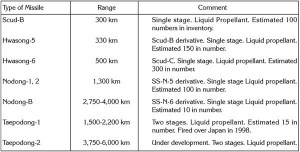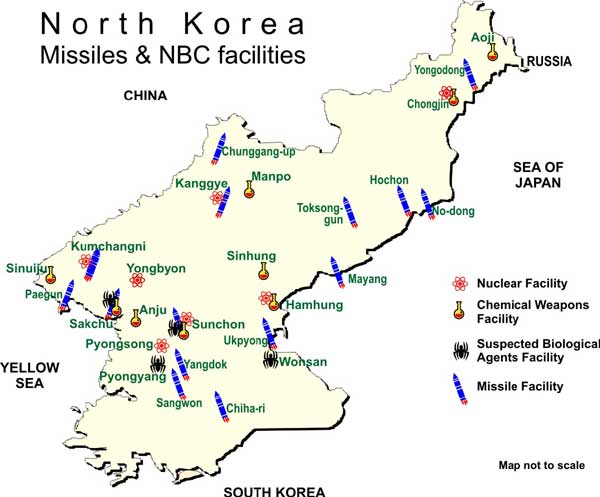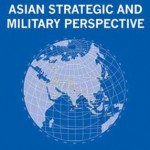North Korea’s missile development programme began in the 1970s and is totally predicated on reverse engineering. To begin with, it reverse engineered Frog-5 missiles and Soviet made Scud-B missiles between 1981 and 1985. The Scud-B missiles were obtained from Egypt and the first reverse engineered version was test launched in 1984. With generous financial aid from Iran, the production of these missiles began in 1987.
During the Iran-Iraq War (1980-88), North Korea is believed to have supplied substantial arms and equipment to Iran, which included ballistic missiles in the later years. Allegedly, it has supplied or collaborated in missile development programmes of Egypt, Syria and Libya. Various sources estimate that North Korean income through sale of ballistic missiles in the 1980s was approximately US $ one billion, which has now been whittled down to less than half that.
North Korea reportedly has uranium mines having four million tonnes of high quality exploitable uranium…
In 1989, North Korea test launched the longer-range Scud-C missiles and by 1991 it was developing a new ballistic missile (Nodong-I) with a range in excess of 900 km. In the mid-1990s, North Korea was actively pursuing the development of Taepodong-1 (test fired in August 1998) and Taepodong-2 missiles with a range of up to 6,000 km. North Korea, however, maintains that the Taepodong missile test launch in 1998 was a part of its space programme. In 1999, it agreed to freeze further tests of long-range missiles, which it has not violated since then.
In late 2000, the US President Bill Clinton proposed an agreement under which North Korea would halt production and testing of medium and long-range missiles, as well as export of missile technology, and in return the US would provide two or three launches of North Korean satellites annually. The Bush Administration also endorsed this framework but with certain caveats.
As per the South Korean Defence Ministry, North Korea had sold 400 Scud-class ballistic missiles to Middle East countries from the 1980s till the year 2003. The biggest buyers were Iran, Yemen, Syria, as also Egypt and Libya. Currently, it is estimated that North Korea’s missile arsenal consists of 600 Scud missiles and 100 Nodong missiles.
The various types of missiles that have been developed by North Korea since 1981 are given in fig.
Nuclear, Chemical, and Biological Weapons Programme
The Democratic People’s Republic of Korea’s (DPRK) nuclear related activities were initiated in the 1950s. In 1956, it signed two agreements with the Soviet Union on joint nuclear research. In 1959, additional agreements on the peaceful usages of nuclear energy were signed with the Soviet Union and China, which envisaged setting up of a nuclear research facility under the Academy of Sciences near Yongbyon. This facility was set up in 1962, at Yong Dong on the Kuryong River, 100 km north of Pyongyang and southwest of the city of Yongbyon. Chinese and Soviet experts provided training assistance to North Korean scientists and technicians in nuclear science. In 1965, a Soviet supplied IRT-2M (two kilowatt) research reactor was assembled at Yongbyon, which became operational in 1967.
 Between 1965 and 1973, fuel enriched to 10 percent was supplied to this reactor. By the late 1970s, with the concurrence of the International Atomic Energy Agency (IAEA), the reactor’s power capacity was increased to approximately 8 kilowatt. North Korea began to further expand its nuclear infrastructure in the mid-1970s. Importantly, in 1980, it undertook construction of another indigenously developed 30 MW reactor, which was gas cooled and graphite moderated. The use of graphite and natural uranium meant that North Korea was no longer hostage to foreign assistance with regard to its nuclear programme. The reactor became operational in 1987.
Between 1965 and 1973, fuel enriched to 10 percent was supplied to this reactor. By the late 1970s, with the concurrence of the International Atomic Energy Agency (IAEA), the reactor’s power capacity was increased to approximately 8 kilowatt. North Korea began to further expand its nuclear infrastructure in the mid-1970s. Importantly, in 1980, it undertook construction of another indigenously developed 30 MW reactor, which was gas cooled and graphite moderated. The use of graphite and natural uranium meant that North Korea was no longer hostage to foreign assistance with regard to its nuclear programme. The reactor became operational in 1987.
However, North Korea has never acknowledged its existence. In the 1980s, North Korea is believed to have developed clandestine nuclear related links with various countries like Libya, Czechoslovakia, East Germany, Cuba, Egypt, Iran and Syria.
In 1989, there was a plethora of evidence corroborated by US satellite pictures regarding the construction of another 200 MW reactor in the Yongbyon area. Many other facilities, such as high explosive testing sites and a re-processing facility were also detected. The construction activities on these new nuclear facilities were first noticed in 1984. In 1985, North Korea acceded to the Nuclear Non-Proliferation Treaty (NPT) under international pressure, however, it refused to sign a safeguards agreement with the IAEA.
…North Korea possesses more than a score of nuclear weapons, a more pragmatic assessment, based on plutonium production capability and other parameters, indicates that it may have been able to assemble just a weapon or two.
Moreover, North Korean intentions had become suspect because the second (30 MW) and the third (200 MW) nuclear reactor had not been connected to any power grid. Further, in 1990, as per US media reports, satellite photographs betrayed the presence of a nuclear structure in Yongbyon, which could be used to separate plutonium from nuclear fuel.
The years 1991 and 1992 generated strong hopes with regard to a solution to the tension created by North Korea’s clandestine nuclear programme. On the last day of 1991, North Korea and South Korea made a joint declaration on denuclearisation of the Korean Peninsula. A North-South Joint Nuclear Control Commission (JNCC) was mandated with the verification of the denuclearisation process. Within a month of the joint declaration, the DPRK also signed a nuclear safeguards agreement with the IAEA. In January 1993, North Korea refused IAEA access to two suspected nuclear waste sites and announced its intent to withdraw from the NPT. North Korea’s obduracy and equivocation with regard to opening up its nuclear facilities for verification prompted the US to revive its Team Spirit series of exercises with South Korea.
In 1994, the US was seriously contemplating the use of force to dismantle North Korea’s nuclear infrastructure. After prolonged negotiations extending for more than a year and half, the US and North Korea signed an agreement in October 1994, by which North Korea agreed not to restart its old nuclear reactors and freeze the construction of two new reactors. It also agreed to fully disclose its past nuclear activities and open its facilities to IAEA officials. In return, the US offered to supply two 1,000 MW light water reactors in order to boost the generation of electricity in North Korea. These reactors would have been safer, with much less plutonium (the core material for atomic weapons) producing capability. Some experts have concluded that when the US and North Korea signed the nuclear agreement in 1994, North Korea had produced enough plutonium for at least one nuclear weapon.
Although, North Korea in compliance with the US-DPRK agreed framework maintained a freeze on its nuclear facilities till the year 2003, it did not come clean on its past nuclear activities, which most importantly, involved the amount of nuclear fuel that had been reprocessed. It refused permission to the IAEA to inspect many suspected nuclear sites. As per its ‘agreed framework’ with the US, for North Korea to be eligible for the supply of two light water reactors (controlled by the Nuclear Supplier Group), it had to render its nuclear programme completely transparent. On 16 October 2002, the US made the shocking revelation that North Korea had admitted to the existence of a nuclear weapons programme in violation of the 1994 agreement.
At the end of 2003, North Korea declared that it was lifting the freeze on facilities frozen under its agreed framework with the US, and subsequently it removed the cameras and broke the UN seal at the nuclear plant at Yongbyon, which was suspected to be engaged in the production of weapons grade plutonium.
…North Korean nuclear posturing as ‘diplomacy by extortion’ in order to secure economic and trade benefits.
North Korea reportedly has uranium mines having four million tonnes of high quality exploitable uranium. It has some 22 nuclear facilities spread over 18 locations. These, apart from uranium mines, include reprocessing facilities, nuclear power plants, nuclear fuel plants and research facilities at Yongbyon and Sunchon. In all probability, it has acquired the expertise to complete the nuclear fuel cycle.
There are wide variations with regards to estimates of nuclear weapons that North Korea may have assembled. While there are alarmists who reckon that North Korea possesses more than a score of nuclear weapons, a more pragmatic assessment, based on plutonium production capability and other parameters, indicates that it may have been able to assemble just a weapon or two.Many experts and intelligence agencies, including the CIA, strongly maintain that North Korea is engaged in a uranium enrichment programme, whose precise status is difficult to ascertain, as unlike a plutonium programme, a uranium programme can be dispersed or hidden underground, thus making satellite imagery extremely difficult. It has emerged that Pakistan has provided crucial assistance to North Korea’s uranium enrichment programme i.e. supply of sample gas centrifuges and its blue print in return for ballistic missile technology or complete missile systems.
Allegedly, the requisite equipment for uranium enrichment was flown in by a special flight from Islamabad to Pyongyang in June 1998. The father of the Pakistani nuclear programme Dr AQ Khan has confessed to helping North Korea in its nuclear weapons programme with the approval of senior military commanders. Dr Khan made some thirteen trips to North Korea. General Jehangir Karamat, the then Pak Army Chief also made a secret trip to North Korea in December 1997.
There have been mentions in the media about a strong possibility regarding North Korea’s collaboration with Pakistan in nuclear tests conducted by the latter in 1998. These reports dubbed these as a ‘Joint Pakistan-North Korea’ tests. Since these tests in the Kharan Desert were conducted at two different locations i.e. at Wazir Khan Khosa (main test) and Ras Koh (second small test), which are at some distance from one another, it lends weight to the suspicion. All the Indian nuclear tests were conducted at one location or in close vicinity to each other. While Pakistan had released pictures of the Ras Koh test it has been cagey about tests conducted at Wazir Khan Khosa.
…there are also reports that North Korea does posses biological warfare capability and could use agents like anthrax, plague or yellow fever against water and food supplies in South Korea’s rear areas in case of a setback during full-scale hostilities.
Some observers have, therefore, deduced that Pakistan has been reticent about the main tests at Wazir Khan Khosa, because it wanted to conceal North Korean collaboration. Moreover, as per reports leaked from the Los Alamos Nuclear Laboratory, air samples collected by US aircraft contained traces of plutonium and Pakistan’s nuclear reactor at PINSTECH did not have sufficient time to produce plutonium required to make a nuclear warhead, and North Korea may have used the opportunity to carryout its own tests of plutonium based weapons. Thus, in the opinion of some analysts Pakistan’s alleged collaboration with North Korea in its nuclear tests in 1998 is plausible.
The US believes that a nuclear weapon capability in the possession of an unpredictable country like North Korea, being ruled on the whims of Kim Jong-Il, is a dangerous tool, which threatens regional security. North Korea maintains that having being branded as a part of the ‘axis of evil’ and delays in setting up of light water reactor by the US has absolved it from the obligation under the ‘94 Accord, and, therefore, its uranium programme is legitimate. Reportedly, the selective disclosures regarding the existence of a uranium programme was a well-deliberated decision by the North Korean leadership in order to gain leverage while negotiating with the US.
Some optimists are also of the view that North Korea is making tentative moves towards opening itself to the world and, therefore, its credibility would have completely eroded if it had not accepted its pursuance of a nuclear weapon programme in the face of incontrovertible evidence. There are other observers who describe the North Korean nuclear posturing as ‘diplomacy by extortion’ in order to secure economic and trade benefits. As opposed to the US policy of final and complete nuclear disarmament of North Korea; Russia, China, South Korea and Japan favour an incremental approach linked with concessions in a gradual and reciprocal manner.
Chemical and Biological Weapons
It is believed that since 1989, North Korea has been producing bulk quantities of nerve, blister, choking and blood chemical agents and that it presently has a sizable stockpile of chemical weapons. It is yet to sign the Chemical Weapons Convention and is not likely to do so in the foreseeable future as it would entail an intrusive inspection regime, which North Korea is acutely averse to. Nevertheless, North Korea acceded to the Biological Weapons Convention in 1987. It is believed that in 1980 North Korea made an accelerated bid in the development of biological weapons on the orders of Kim-II Sung.
The inputs available on North Korean biological weapons programme are nebulous. Some experts aver that given the geographical proximity and ethnic affinity of North Korea and South Korea, the former may find biological weapons as a deplorable option. Nevertheless, there are also reports that North Korea does posses biological warfare capability and could use agents like anthrax, plague or yellow fever against water and food supplies in South Korea’s rear areas in case of a setback during full-scale hostilities.
The known and suspected missile, nuclear, chemical and biological weapons facilities are indicated on the map.






